Вы здесь
Dossor village.
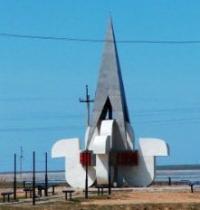
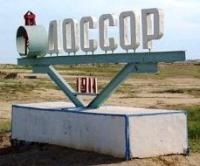
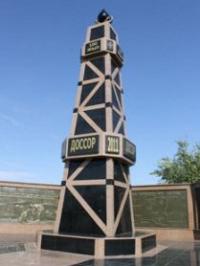
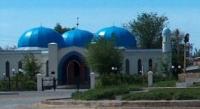
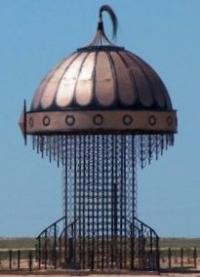
Historical tour Kazakhstan.
“The oil workers felt that everyone began to love them, and they want to take advantage of the fruits of this love in full. Naturally, we resist."
Alexander Livshits.
Ancient Cities Tour to Kazakhstan.
2011 marked the 100th anniversary of the Dossor oil industry in Makat region. A historical obelisk was opened in the Dossor settlement of the Makat region, and a symbolic oil rig appeared in the park of the Munayshy culture center.
Here the oilmen's alley of fame was broken. In the XVIIIth century, many prominent scientists, geologists, topographers and travelers were engaged in the study of potential oil and gas deposits in the Ural-Emba region.
In 1890, the expedition of Grigory Grumm-Grzhimailo compiled a detailed geological characteristic of the Karachungul massif. In 1892, a special expedition of the Geological Committee headed by the famous geologist Sergei Nikitin was sent to study oil manifestations, she organized prospecting work and cut several wells in the areas of Dossor, Iskine, Karachungul.
Due to the maximum manifestations of oil on the surface of the earth and in salt lakes, as well as in connection with a number of other favorable circumstances, drilling operations reached the highest concentration precisely in Dossor, where in 1911, when drilling well No. 3, an oil gusher was obtained.
Two years later, more than two thousand people worked at the Dossor fields, and in general, about six thousand people worked at Emba. Dossor became a real oil town - by 1913, about a dozen residential buildings for workers, barracks, barracks, a hospital, baths, canteens, a school, a club, bakeries, a power station were already built there, and even a telephone connection was organized, which was unprecedented in those days luxury for the steppe.
Since the beginning of development, 5 million 120 thousand tons of oil have been extracted from the depths of Dossor, including 4 million 800 thousand tons from the main deposit. In the first years of the development of the field, the oilmen had to work in very difficult conditions.
There were no transport links here. Therefore, the oil produced in Dossor was transported in special wineskin bags on pack camels to Khiva and along the Caspian Sea to the port of Rakusha, from there it was exported by tankers by sea to Astrakhan for further sale on the market.
There is even a legend among local oilmen that it was in Dossor that the tradition arose to take a barrel as a unit of measurement for oil. According to them, the camels could carry a limited number of barrels of crude oil on their backs.
And since the British were the first to extract hydrocarbons here, the name came from the English language: barrel - a barrel. A little later, all products began to be exported by sea, where oil was supplied through two pipelines, in order to then go for processing at two small refineries.
The products of the factories were pumped to sea barges via a 16-kilometer oil pipeline laid along the seabed. Then the first 65 km long Dossor - Rakusha oil pipeline was built, through which oil was pumped.
It was in those years that the local population, who had previously been engaged in cattle breeding and fishing, was involved in the oil business and the beginning of the oil industry was laid in the west of the republic.
The Soviet government understood well the significance of Dossor and Makat. In 1914, in the Russian Empire, the Ural-Emba region ranked third in terms of production after Baku and Grozny. The oil was light, low-sulfur and slightly paraffinic.
But due to the First World War, the revolution, and after the civil war, the production rates remained insignificant. It was possible to restore the work of the fields only by the mid-20s. At the same time, large-scale geological research began on the Emba, primarily around Dossor.
By the end of the 1920s, over 300 domes were identified within the southern part of the Caspian basin. In 1931, Baichunas and Sagyz were commissioned, in 1934 - Eskene and in 1935 - Kosshagyl. The volume of the Emba oil reserves in 1937 increased from 21 to 31 million tons, and oil production in the pre-war years was 700 - 750 thousand tons.
The oil workers of Dossor, with their selfless labor, made an invaluable contribution to the victory of the Soviet Union in the Great Patriotic War. On June 22, 1941, Dossor's workers gathered for a rally to declare that they were ready to provide as much high-quality oil as Soviet pilots, tankmen, and sailors would need to defeat the Nazi invaders.
Front-line brigades were organized at all oil fields, which worked day and night. The daily production in the second half of 1941 more than doubled in comparison with the pre-war half of the year. Oily oil of the Emba region met all the requirements of new military equipment, especially aircraft engine building.
Also, due to its high quality, it went without processing to refueling tanks. From the first days of the war, the oil workers switched to a 12-hour work schedule in order to supply the front with high-quality oil, fuels and lubricants.
During the four years of the war, the Emba oil workers produced 40 percent more raw materials than in the corresponding period before the war. New fields were discovered: Komsomolskoye, Zholdybai, Tenteksor, Yuzhny Koshkar.
During the war, the school of factory apprenticeship (FZU) No. 16 in Dossor trained about one and a half thousand drillers, tractor drivers, and repairmen. And it was precisely these specialists who, with their hard work, did not allow oil production to stop, and did everything possible to develop production.
During the war years, Eskene's fishery won the challenge Red Banner of the State Defense Committee nine times. And Baychunas was awarded the title of "The best craft of the Union". In the 1930s, the Dossor - Guryev and Caspian - Orsk oil pipelines were built.
Currently, along with the development of deposits, the development of younger giants, such as Tengiz and the Korolevskoye field, is underway on the Dossor land. Oil production is carried out not only on land, but also on the shelf of the Caspian Sea.
Authority:
The book "Oil of Kazakhstan", 2088. Gulsum Zhunusova, Atyrau.
Photos by
Alexander Petrov.







